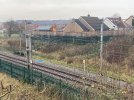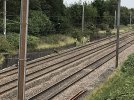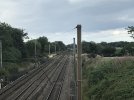LNW-GW Joint
Veteran Member
NR has published its CP7 plans, and there are detailed documents on its web site, on a Region/Route basis.

 www.networkrail.co.uk
www.networkrail.co.uk
There's a lot of generic stuff here, but some specific deliverables are mentioned:
I'm sure there are similar nuggets in the other Regional sections.
Major enhancements are of course not included, as these are funded separately.
Renewing the OLE from Weaver Jn-Catterall would seem to give the lie to previous statements that the entire WCML fast lines were rewired during WCRM (CP2/3).
ETCS now seems to be embedded in the northern WCML plans.
In the accompanying maps, they forgot to delete HS2 phase 2.
There were no specific deliverables in the Central area (West Midlands/Chiltern).
WCS = West Coast South Route (Euston-south of Crewe).
For Wales & Western, some specifics are:
Resignalling at Plymouth
New S&C at Westbury South, Cardiff West and in the Thames Valley
Building the GW/HS2 interchange station at Old Oak Common ("to be open by 2030").
Conversion of the headspan OLE system Paddington-Airport Jn
Renewal of the rigid conductor system in the Severn Tunnel*
Renewal of the ETCS hardware on the Cambrian network
*It hardly seems 5 minutes since this system was installed (2020).

Our Control Period 7 (CP7) delivery plans - Network Rail
Our Control Period 7 (CP7) delivery plan sets out our planned activities, outputs and expenditure of operating, maintaining and renewing the mainline railway infrastructure in Great Britain (GB) over the next five years (between 1 April 2024 and 31 March 2029). It does not include any...
There's a lot of generic stuff here, but some specific deliverables are mentioned:
North West & Central:
• Renewal of the Overhead Line Equipment (OLE) from Preston Brook to Catterall will improve the asset condition and resilience of the line. We are reviewing stressing ranges on OLE before heat-related speed restrictions are required to improve reliability, resilience and reduce the maintenance burden.
• We will commence a programme of re-signalling in the Carlisle, Preston and Warrington areas, starting the transition to modern European Train Control System (ETCS) signalling. This will be the first implementation of ETCS in the NW route and will increase capacity on the WCML and enable HS2 trains to run on our infrastructure, reducing maintenance workload and removing signal sighting problems.
...
• Collaborative working systems: WCS is actively embracing innovative collaboration methods to improve financial efficiency, ensuring smoother operations for both passengers and freight with minimal disruption.
• Hanslope switches and crossings renewal: enhancing the reliability and performance of critical assets within WCS, ensuring a robust and reliable railway.
• Promoting safety through level crossing closures: WCS is undertaking level crossing closures in Marston and Kempston as part of a comprehensive risk reduction strategy, prioritising the safety of both the public and railway users.
• Revitalising for passenger safety: the full platform renewal at Milton Keynes underscores our commitment to passenger safety, helping to ensure the longevity of essential infrastructure for a secure and reliable commuting experience.
I'm sure there are similar nuggets in the other Regional sections.
Major enhancements are of course not included, as these are funded separately.
Renewing the OLE from Weaver Jn-Catterall would seem to give the lie to previous statements that the entire WCML fast lines were rewired during WCRM (CP2/3).
ETCS now seems to be embedded in the northern WCML plans.
In the accompanying maps, they forgot to delete HS2 phase 2.
There were no specific deliverables in the Central area (West Midlands/Chiltern).
WCS = West Coast South Route (Euston-south of Crewe).
For Wales & Western, some specifics are:
Resignalling at Plymouth
New S&C at Westbury South, Cardiff West and in the Thames Valley
Building the GW/HS2 interchange station at Old Oak Common ("to be open by 2030").
Conversion of the headspan OLE system Paddington-Airport Jn
Renewal of the rigid conductor system in the Severn Tunnel*
Renewal of the ETCS hardware on the Cambrian network
*It hardly seems 5 minutes since this system was installed (2020).
Last edited:







